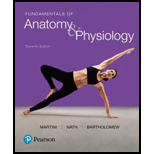
Fundamentals of Anatomy & Physiology (11th Edition)
11th Edition
ISBN: 9780134396026
Author: Frederic H. Martini, Judi L. Nath, Edwin F. Bartholomew
Publisher: PEARSON
expand_more
expand_more
format_list_bulleted
Concept explainers
Question
Chapter 24, Problem 35CP
Summary Introduction
To discuss:
The diarrhea is potentially life threatening, but constipation is not.
Introduction:
In diarrhea, the formation of faeces is in the liquid form. The condition of individual is weak and diarrhea also causes dehydration in the body. The constipation makes the bowel movement hard to pass.
Expert Solution & Answer
Want to see the full answer?
Check out a sample textbook solution
Students have asked these similar questions
7. Aerobic respiration of a protein that breaks down into 12 molecules of malic acid. Assume there is no
other carbon source and no acetyl-CoA.
NADH
FADH2
OP ATP
SLP ATP
Total ATP
Show your work using dimensional analysis here:
3
For each of the following problems calculate the following: (Week 6-3 Video with 6-1 and 6-2)
Consult the total catabolic pathways on the last page as a reference for the following questions.
A. How much NADH and FADH2 is produced and fed into the electron transport chain (If any)?
B. How much ATP is made from oxidative phosphorylation (OP), if any? Feed the NADH and FADH2 into the
electron transport chain: 3ATP/NADH, 2ATP/FADH2
C. How much ATP is made by substrate level phosphorylation (SLP)?
D. How much total ATP is made? Add the SLP and OP together.
1. Aerobic respiration using 0.5 mole of glucose?
NADH
FADH2
OP ATP
SLP ATP
Total ATP
Show your work using dimensional analysis here:
Aerobic respiration of one lipid molecule. The lipid is composed of one glycerol molecule connected to two
fatty acid tails. One fatty acid is 12 carbons long and the other fatty acid is 18 carbons long in the figure
below. Use the information below to determine how much ATP will be produced from the glycerol part of
the lipid. Then, in part B, determine how much ATP is produced from the 2 fatty acids of the lipid. Finally
put the NADH and ATP yields together from the glycerol and fatty acids (part A and B) to determine your
total number of ATP produced per lipid. Assume no other carbon source is available.
18 carbons
fatty acids
12 carbons
glycerol
. Glycerol is broken down to glyceraldehyde 3-phosphate, a glycolysis intermediate via the following
pathway shown in the figure below. Notice this process costs one ATP but generates one FADH2. Continue
generating ATP with glyceraldehyde-3-phosphate using the standard pathway and aerobic respiration.
glycerol
glycerol-3-
phosphate…
Chapter 24 Solutions
Fundamentals of Anatomy & Physiology (11th Edition)
Ch. 24 - Prob. 1CPCh. 24 - Prob. 2CPCh. 24 - Prob. 3CPCh. 24 - Prob. 4CPCh. 24 - Name the layers of the gastrointestinal tract...Ch. 24 - Which is more efficient in propelling intestinal...Ch. 24 - Prob. 7CPCh. 24 - Prob. 8CPCh. 24 - Prob. 9CPCh. 24 - Prob. 10CP
Ch. 24 - Prob. 11CPCh. 24 - Prob. 12CPCh. 24 - Prob. 13CPCh. 24 - Name the structure connecting the pharynx to the...Ch. 24 - Prob. 15CPCh. 24 - Identify the muscles associated with the pharynx...Ch. 24 - What is occurring when the soft palate and larynx...Ch. 24 - Name the four major regions of the stomach.Ch. 24 - Prob. 19CPCh. 24 - Prob. 20CPCh. 24 - Prob. 21CPCh. 24 - The digestion of which nutrient would be most...Ch. 24 - Prob. 23CPCh. 24 - Prob. 24CPCh. 24 - Name the three regions of the small intestine from...Ch. 24 - Prob. 26CPCh. 24 - Prob. 27CPCh. 24 - How would the pH of the intestinal contents be...Ch. 24 - Prob. 29CPCh. 24 - Name some major histological differences between...Ch. 24 - Prob. 31CPCh. 24 - Prob. 32CPCh. 24 - Prob. 33CPCh. 24 - Prob. 34CPCh. 24 - Prob. 35CPCh. 24 - Prob. 36CPCh. 24 - Prob. 37CPCh. 24 - What body systems may be affected by inadequate...Ch. 24 - The enzymatic breakdown of large molecules into...Ch. 24 - Prob. 2RQCh. 24 - Prob. 3RQCh. 24 - Prob. 4RQCh. 24 - Prob. 5RQCh. 24 - Prob. 6RQCh. 24 - Prob. 7RQCh. 24 - Prob. 8RQCh. 24 - Prob. 9RQCh. 24 - Prob. 10RQCh. 24 - Prob. 11RQCh. 24 - Prob. 12RQCh. 24 - Prob. 13RQCh. 24 - Prob. 14RQCh. 24 - Prob. 15RQCh. 24 - What three basic mechanisms regulate the...Ch. 24 - Prob. 17RQCh. 24 - What are the primary digestive functions of the...Ch. 24 - Prob. 19RQCh. 24 - What are the three primary functions of the large...Ch. 24 - What two positive feedback loops are involved in...Ch. 24 - Prob. 22RQCh. 24 - Prob. 23RQCh. 24 - Prob. 24RQCh. 24 - Through which layers of a molar would an oral...Ch. 24 - Prob. 26RQCh. 24 - Prob. 27RQCh. 24 - Prob. 28RQCh. 24 - Some people with gallstones develop pancreatitis....Ch. 24 - Prob. 30RQCh. 24 - A condition known as lactose intolerance is...Ch. 24 - Prob. 32RQCh. 24 - Prob. 1CCCh. 24 - Prob. 2CC
Knowledge Booster
Learn more about
Need a deep-dive on the concept behind this application? Look no further. Learn more about this topic, biology and related others by exploring similar questions and additional content below.Similar questions
- Don't copy the other answerarrow_forward4. Aerobic respiration of 5 mM acetate solution. Assume no other carbon source and that acetate is equivalent to acetyl-CoA. NADH FADH2 OP ATP SLP ATP Total ATP Show your work using dimensional analysis here: 5. Aerobic respiration of 2 mM alpha-ketoglutaric acid solution. Assume no other carbon source. NADH FADH2 OP ATP Show your work using dimensional analysis here: SLP ATP Total ATParrow_forwardBiology You’re going to analyze 5 ul of your PCR product(out of 50 ul) on the gel. How much of 6X DNAloading buffer (dye) are you going to mix with yourPCR product to make final 1X concentration ofloading buffer in the PCR product-loading buffermixture?arrow_forward
- Write the assignment on the title "GYMNOSPERMS" focus on the explanation of its important families, characters and reproduction.arrow_forwardAwnser these Discussion Questions Answer these discussion questions and submit them as part of your lab report. Part A: The Effect of Temperature on Enzyme Activity Graph the volume of oxygen produced against the temperature of the solution. How is the oxygen production in 30 seconds related to the rate of the reaction? At what temperature is the rate of reaction the highest? Lowest? Explain. Why might the enzyme activity decrease at very high temperatures? Why might a high fever be dangerous to humans? What is the optimal temperature for enzymes in the human body? Part B: The Effect of pH on Enzyme Activity Graph the volume of oxygen produced against the pH of the solution. At what pH is the rate of reaction the highest? Lowest? Explain. Why does changing the pH affect the enzyme activity? Research the enzyme catalase. What is its function in the human body? What is the optimal pH for the following enzymes found in the human body? Explain. (catalase, lipase (in your stomach),…arrow_forwardAnwser these Discussion Questions: Part One Why were the plants kept in the dark prior to the experiment? Why is this important? Why is it important to boil the leaf? Explain why it was necessary to use boiling alcohol? What is the purpose of the iodine? Part Two What was the purpose of keeping the leaf in the dark and then covering it with a cardboard cut-out? What conclusions can you draw from this part of the lab? Part Three 7. In this experiment what was the purpose of adding the soda lime? 8. Why was a sealed bag placed around each plant? 9. What happened in the control plants? 10. What was the result on photosynthesis? Part Four 11. Why was a variegated leaf used in this experiment? !2. What conclusions can you draw about starch production in a variegated leaf?arrow_forward
- How did the color differences between the two bacterial species you used in this experiment help you determine if the streak plate method you performed was successful?arrow_forwardseries of two-point crosses were carried out among six loci (a, b, c, d, e and f), producing the following recombination frequencies. According to the data below, the genes can be placed into how many different linkage groups? Loci a and b Percent Recombination 50 a and c 14 a and d 10 a and e 50 a and f 50 b and c 50 b and d 50 b and e 35 b and f 20 c and d 5 c and e 50 c and f 50 d and e 50 d and f 50 18 e and f Selected Answer: n6 Draw genetic maps for the linkage groups for the data in question #5. Please use the format given below to indicate the genetic distances. Z e.g. Linkage group 1=P____5 mu__Q____12 mu R 38 mu 5 Linkage group 2-X_____3 mu__Y_4 mu sanightarrow_forwardWhat settings would being able to isolate individual bacteria colonies from a mixed bacterial culture be useful?arrow_forward
- Can I get a handwritten answer please. I'm having a hard time understanding this process. Thanksarrow_forwardSay you get AATTGGCAATTGGCAATTGGCAATTGGCAATTGGCAATTGGCAATTGGC 3ʹ and it is cleaved with Mspl restriction enzyme - how do I find how many fragments?arrow_forwardWhat is amplification bias?arrow_forward
arrow_back_ios
SEE MORE QUESTIONS
arrow_forward_ios
Recommended textbooks for you
 Medical Terminology for Health Professions, Spira...Health & NutritionISBN:9781305634350Author:Ann Ehrlich, Carol L. Schroeder, Laura Ehrlich, Katrina A. SchroederPublisher:Cengage LearningEssentials of Pharmacology for Health ProfessionsNursingISBN:9781305441620Author:WOODROWPublisher:Cengage
Medical Terminology for Health Professions, Spira...Health & NutritionISBN:9781305634350Author:Ann Ehrlich, Carol L. Schroeder, Laura Ehrlich, Katrina A. SchroederPublisher:Cengage LearningEssentials of Pharmacology for Health ProfessionsNursingISBN:9781305441620Author:WOODROWPublisher:Cengage Human Physiology: From Cells to Systems (MindTap ...BiologyISBN:9781285866932Author:Lauralee SherwoodPublisher:Cengage Learning
Human Physiology: From Cells to Systems (MindTap ...BiologyISBN:9781285866932Author:Lauralee SherwoodPublisher:Cengage Learning Nutrition Through The Life CycleHealth & NutritionISBN:9781337919333Author:Brown, Judith E.Publisher:Cengage Learning,
Nutrition Through The Life CycleHealth & NutritionISBN:9781337919333Author:Brown, Judith E.Publisher:Cengage Learning,

Medical Terminology for Health Professions, Spira...
Health & Nutrition
ISBN:9781305634350
Author:Ann Ehrlich, Carol L. Schroeder, Laura Ehrlich, Katrina A. Schroeder
Publisher:Cengage Learning

Essentials of Pharmacology for Health Professions
Nursing
ISBN:9781305441620
Author:WOODROW
Publisher:Cengage


Human Physiology: From Cells to Systems (MindTap ...
Biology
ISBN:9781285866932
Author:Lauralee Sherwood
Publisher:Cengage Learning

Nutrition Through The Life Cycle
Health & Nutrition
ISBN:9781337919333
Author:Brown, Judith E.
Publisher:Cengage Learning,
